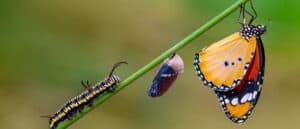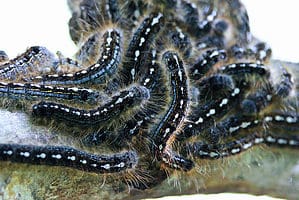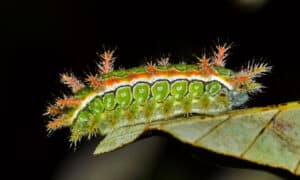Montana is a breathtaking state known for its stunning landscapes and diverse wildlife. The state is home to various creatures, some large, like the American bison, and some small, such as caterpillars. Caterpillars play a fascinating role in the ecosystem. However, not all caterpillars in Montana are harmless; some can be poisonous! It is crucial to be aware of these toxic species and understand their distinctive characteristics in order to coexist safely. In this article, we will discuss 15 caterpillars found in Montana, spoiler alert! Six of these species are poisonous.
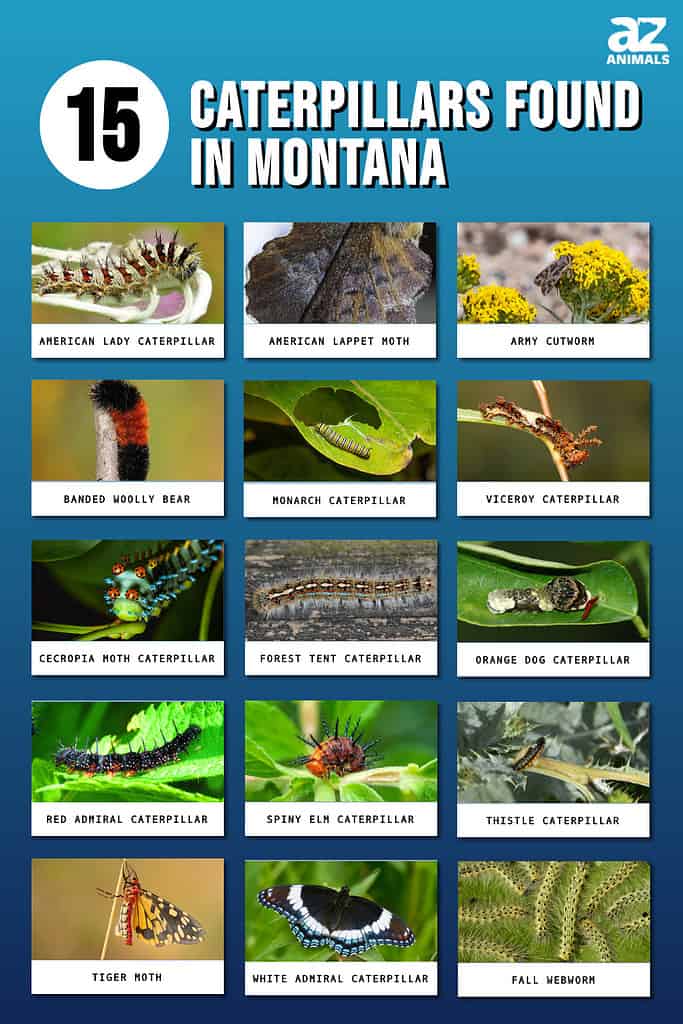
1. American Lady Caterpillar (Vanessa virginiensis)
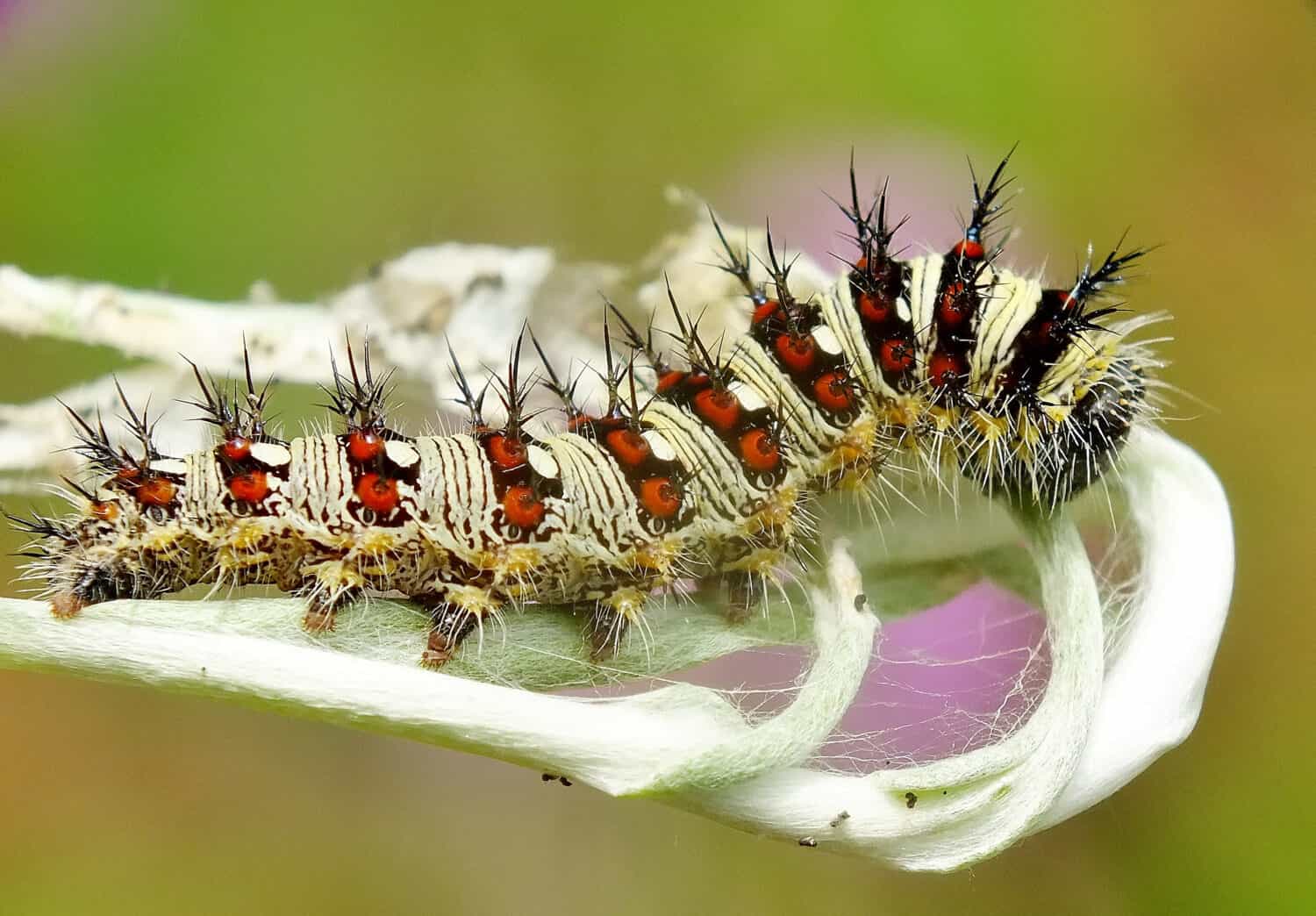
This caterpillar has spikes on its body that can potentially harm you.
©AnaGoncalves93/Shutterstock.com
The American lady caterpillar, found in Montana, is characterized by black, branching spikes that emerge from red-orange dots on its body. It is advised not to handle this caterpillar due to these spikes.
Each segment of the caterpillar has two white dots accompanied by these spiky growths. The American lady caterpillar displays a range of color variations. Some individuals have alternating black and thin white or yellow bands, while others exhibit orange or brown hues with yellow bands.
In terms of diet, American lady caterpillars consume the leaves of pussytoes, everlastings, and other plants belonging to the sunflower family.
During the daytime, the caterpillar remains concealed within the nest, emerging only on cloudy days and at night to continue its feeding activities.
2. American Lappet Moth (Phyllodesma Americana)
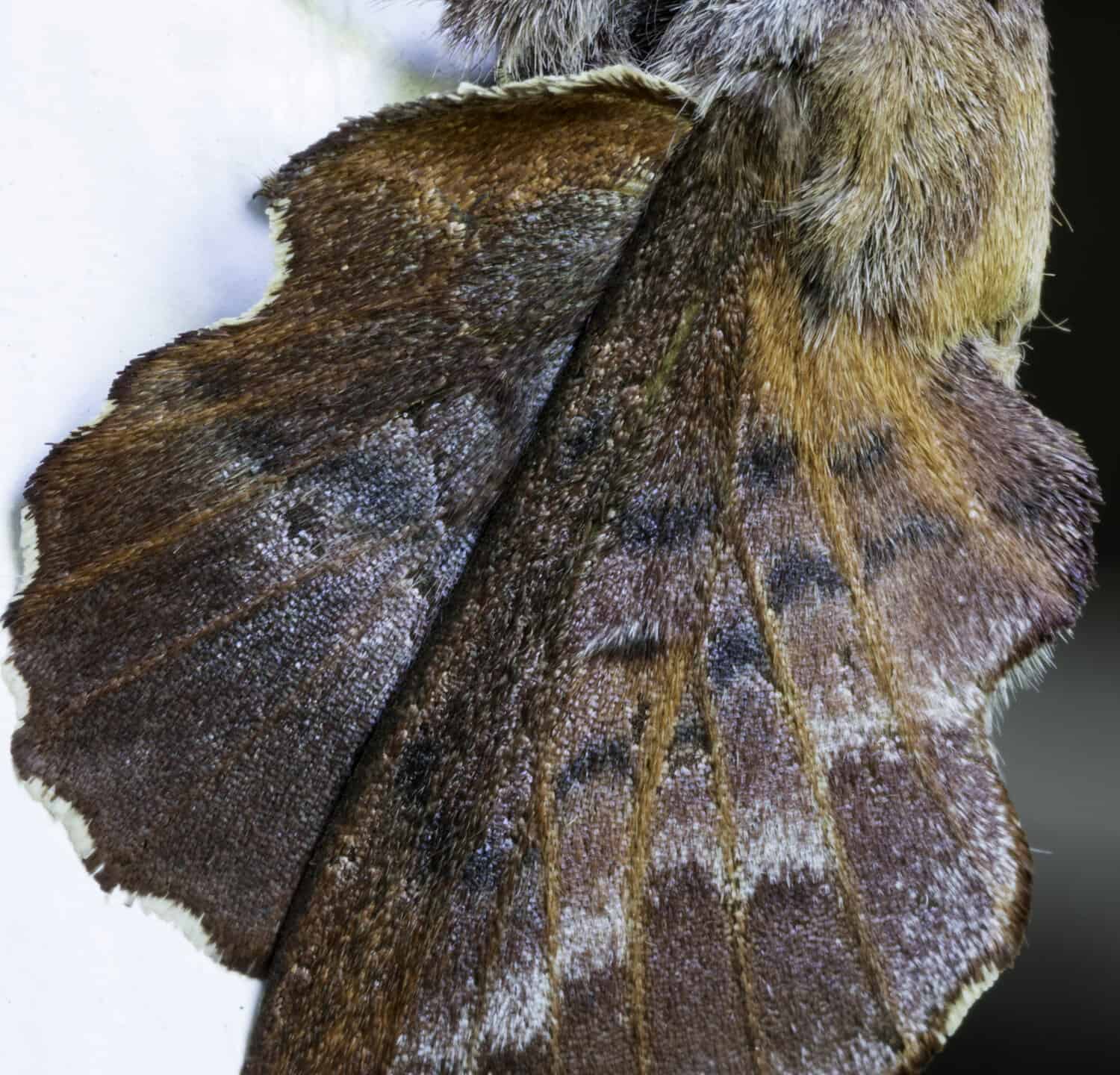
When fully developed, the American lappet moth can disguise itself as a leaf.
©Stewart Myers/Shutterstock.com
The American lappet moth’s caterpillar possesses hairy lobes extending along the sides of its body. These lobes are covered in dense hair and are notable features that help to identify this caterpillar.
This caterpillar has a gray body with occasional hints of green or blue. Some American lappet moths also have fringes of orange coloring near their legs, while others have orange flecks on their dorsal side.
The American lappet moth caterpillars do not have a specific diet. They tend to consume a wide variety of leaves they come across. They are constantly growing, so the caterpillars require large amounts of food to support their development into moths.
The hairs of lappet moth caterpillars contain a toxin that can cause a stinging sensation and itching when they come into contact with the skin.
3. Army Cutworm (Euxoa auxiliaries)
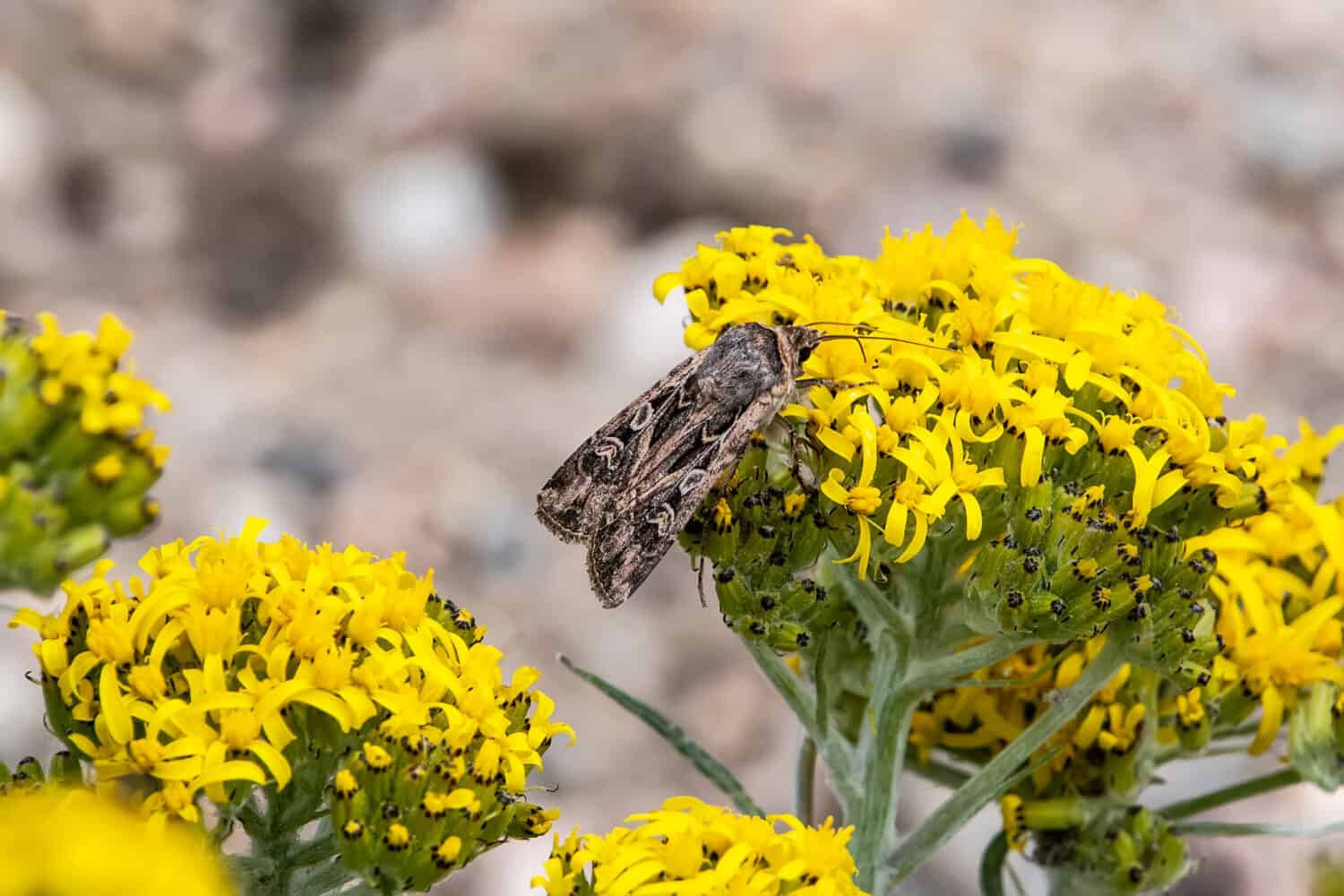
This is what army cutworms look like when they develop into moths.
©William Cushman/Shutterstock.com
There are a few types of caterpillars in Montana that are collectively known as plant pests. One example of a pest caterpillar is the army cutworm. This caterpillar has an olive, brown, or drab gray coloration that helps it blend in with the soil.
The army cutworm’s body is adorned with spaced-apart small black dots, and it features a pale band running down its “spine.” When exposed or threatened, this plump caterpillar can curl up, tucking its head underneath itself for protection.
The army cutworm caterpillar feeds on the foliage of crops such as wheat, barley, flax, sweet clover, peas, and sugar beet, as well as various weeds, notably stinkweed, and grasses.
As the name suggests, army cutworms exhibit a behavior where they cut through the roots of plants while feeding on them, which can ultimately lead to the death of the plant. This is why Montanans consider these caterpillars to be pests.
4. Banded Woolly Bear (Pyrrharctia Isabella)
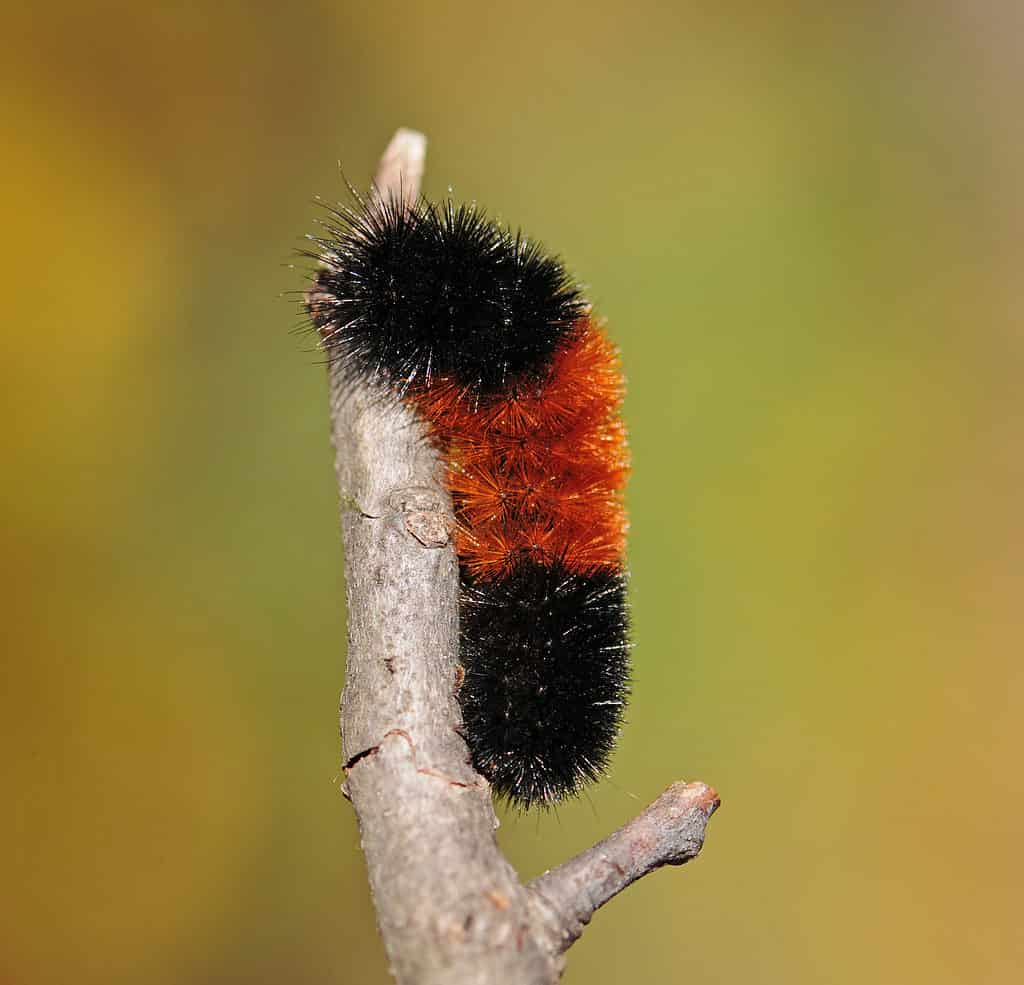
This banded woolly bear is an extremely fuzzy caterpillar!
©Nancy Bauer/Shutterstock.com
Another common caterpillar found in Montana is the banded woolly bear. Despite being covered in dense black and rust-colored spiky hairs, the banded woolly bear caterpillar is safe to handle. Its head and rear end are black, while a middle b/and of color can range from red to maroon or even somewhat brown. As the larva grows, this middle band expands, gradually replacing the black sections.
The banded woolly bear caterpillar primarily feeds on weeds but also consumes some flowers, grasses, and tree leaves. Fortunately, its feeding habits generally do not cause significant damage to the plants, so there is usually no need to control their population.
These caterpillars are frequently observed in autumn as they search for suitable shelters to spend the coldest season. According to legend, the width of the center band of color on their body is believed to predict the length of winter: a wider band suggests a longer winter ahead.
5. Monarch Caterpillar (Danaus plexippus)
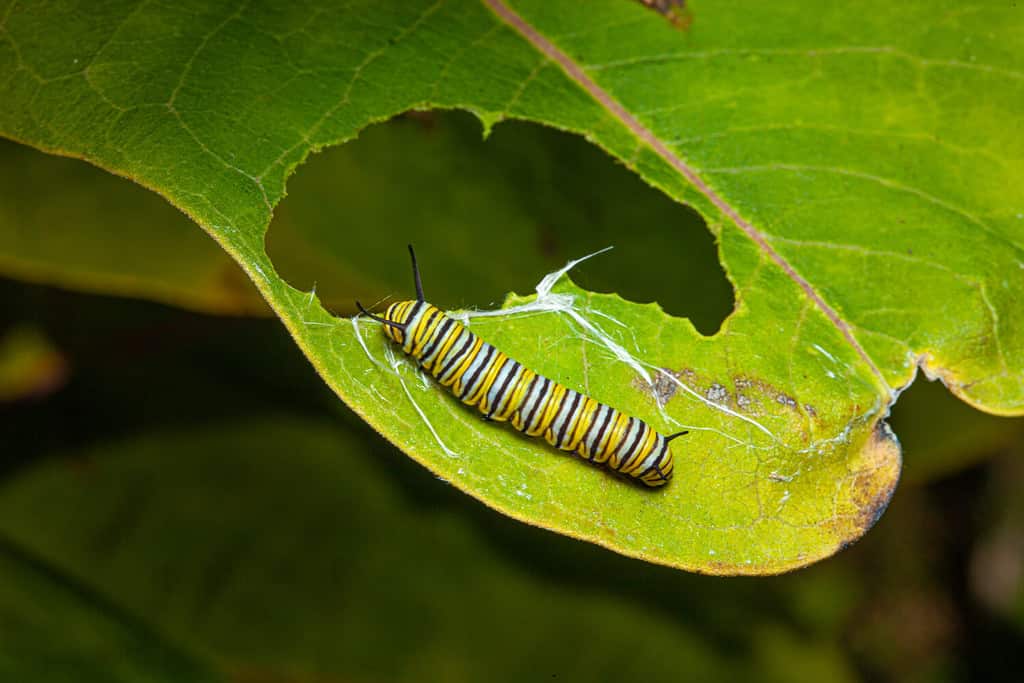
These caterpillars are toxic due to their feeding habits of exclusively eating milkweed.
©K Hanley CHDPhoto/Shutterstock.com
Monarch caterpillars exhibit distinctive yellow, black, and white stripes along their bodies. At each end of their body, they possess antennae-like tentacles. Before undergoing metamorphosis, these caterpillars typically grow to a length of around two inches.
Monarch caterpillars exclusively feed on consuming milkweed leaves.
These insects possess a unique toxin that serves as a defense mechanism, making them highly poisonous and potentially dangerous. Interestingly, they do not produce this toxin themselves. Instead, their toxicity comes from the specific diet they consume during their larval stage, which helps in protecting the species.
6. Viceroy Caterpillar (Limenitis archippus)
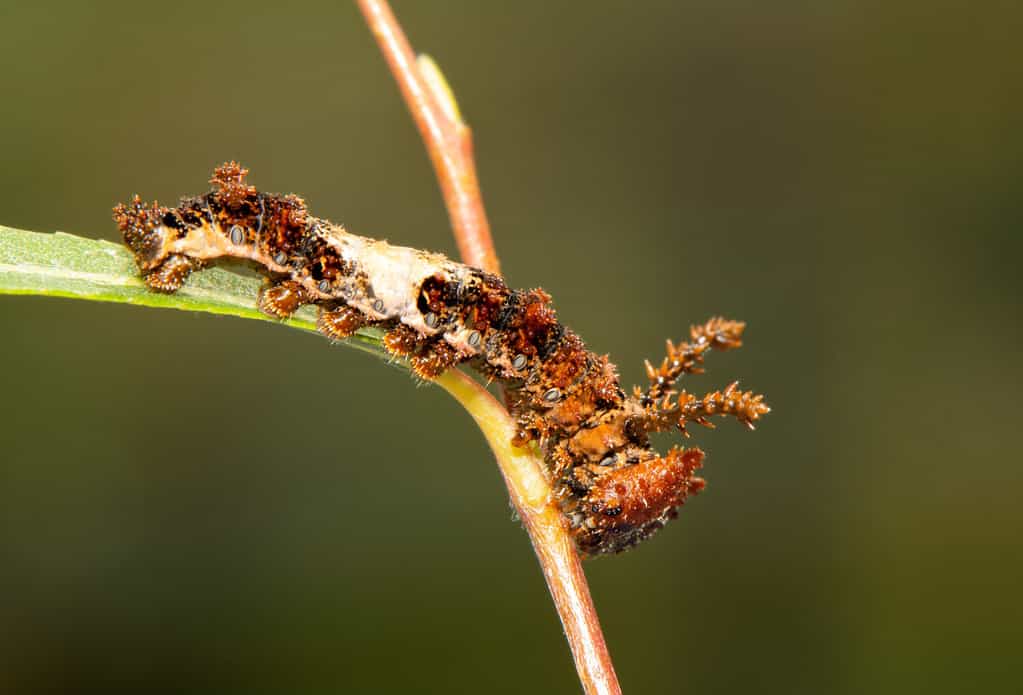
These caterpillars disguise themselves as droppings to avoid predation.
©Sari ONeal/Shutterstock.com
The viceroy caterpillar resembles bird droppings throughout its various stages of development. It can display a mottled brown or green coloration, featuring creamy blotches and two knobby horns on its thorax.
While the preferred food of Viceroy caterpillars is willow, they can also consume poplar, aspen, and even plants from the rose family. Interestingly, the caterpillar incorporates salicylic acid from willow leaves into its body. These caterpillars primarily feed at night and utilize the leaf stems devoid of foliage as perches during the daytime.
In recent discoveries, it has been found that viceroy caterpillars are also toxic.
7. Cecropia Moth Caterpillar (Hyalophora cecropia)
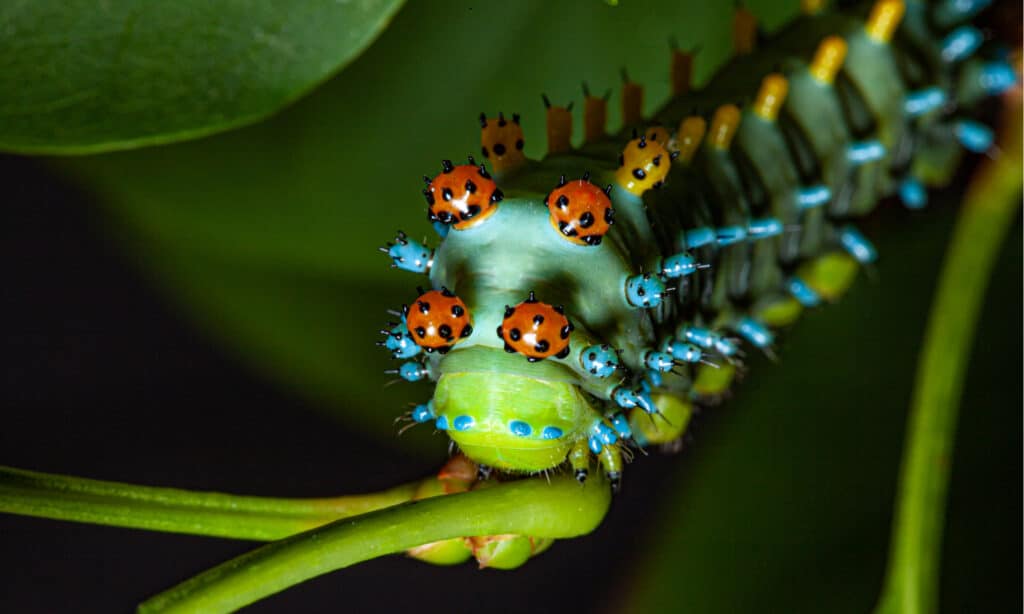
The cecropia moth caterpillar has a distinctive warning coloration.
©K Hanley CHDPhoto/Shutterstock.com
The caterpillars of the cecropia moth undergo a lengthy maturation process during most of the summer and can reach an impressive length of up to four inches when fully grown. They are among the largest caterpillars found in Montana.
These caterpillars have a bluish-green coloration, and each body segment along their back is adorned with a pair of yellow projections. The diet of the cecropia caterpillar consists of the leaves of various trees and shrubs, including ash, box elder, elm, maple, wild cherry, plum, apple, and lilac.
While the caterpillar itself is not poisonous, its unique appearance serves as a deterrent to some predators due to its funky and unusual appearance.
8. Forest Tent Caterpillar (Malacosoma disstria)

This caterpillar is considered a pest as it consumes lots of leaves and trees, destroying vegetation.
©jcohen9/Shutterstock.com
The forest tent caterpillar, although harmless in terms of stinging or biting humans, can become a nuisance or even a significant pest in certain situations.
This caterpillar has a dark brown or black body with light blue stripes and thin yellow lines on each side of its “spine.” Each segment of its body is marked with a white shoe-shaped print, and fine white hairs protrude from its lower sides, face, and rear end. While resembling the eastern tent caterpillar, it lacks the solid cream line on the “spine” found in the latter species.
When it comes to diet, forest tent caterpillars feed on a variety of broadleaved trees and shrubs. In Montana, they appear to be particularly abundant in oaks, sweet gum, black gum, and tupelo.
9. Orange Dog Caterpillar (Papilio cresphontes)
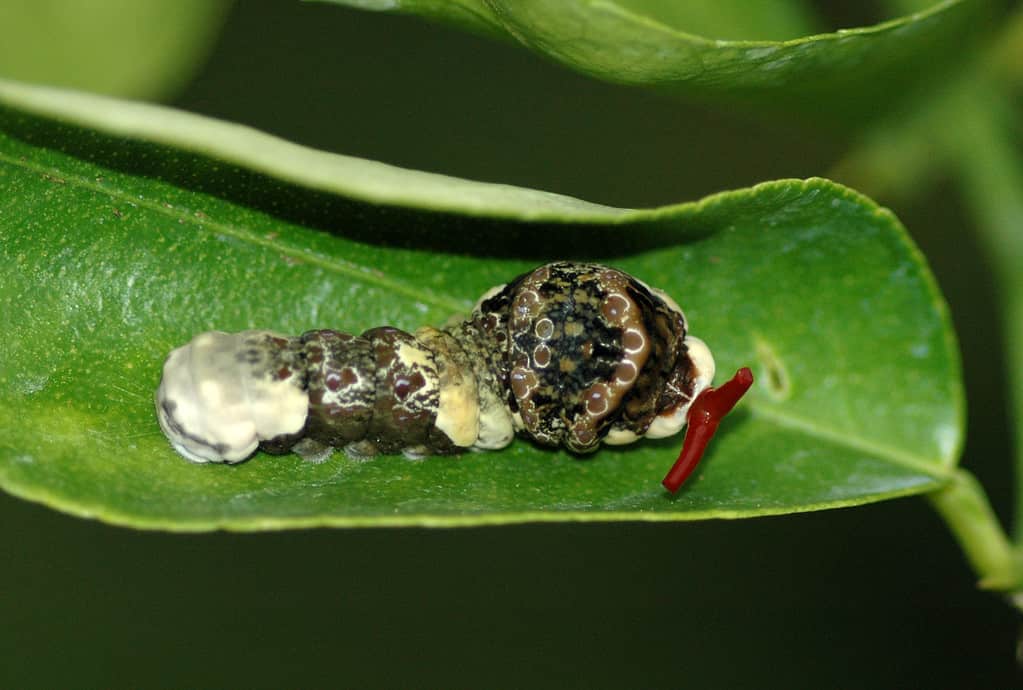
The orange dog caterpillar resembles bird droppings.
The orange dog caterpillar has a peculiar appearance resembling bird droppings when found on citrus tree leaves. While not particularly appealing in their larva or caterpillar stage, they undergo pupation and transform into the beautiful giant swallowtail butterfly (Heraclides cresphonte).
These caterpillars, known as orange dogs, primarily feed on tender citrus leaves. While they may occasionally defoliate young trees, they rarely cause significant damage in mature orchards.
Despite their eerie appearance, it’s important to note that orange dog caterpillars are harmless and do not possess any stinging capabilities.
10. Red Admiral Caterpillar (Vanessa atalanta)
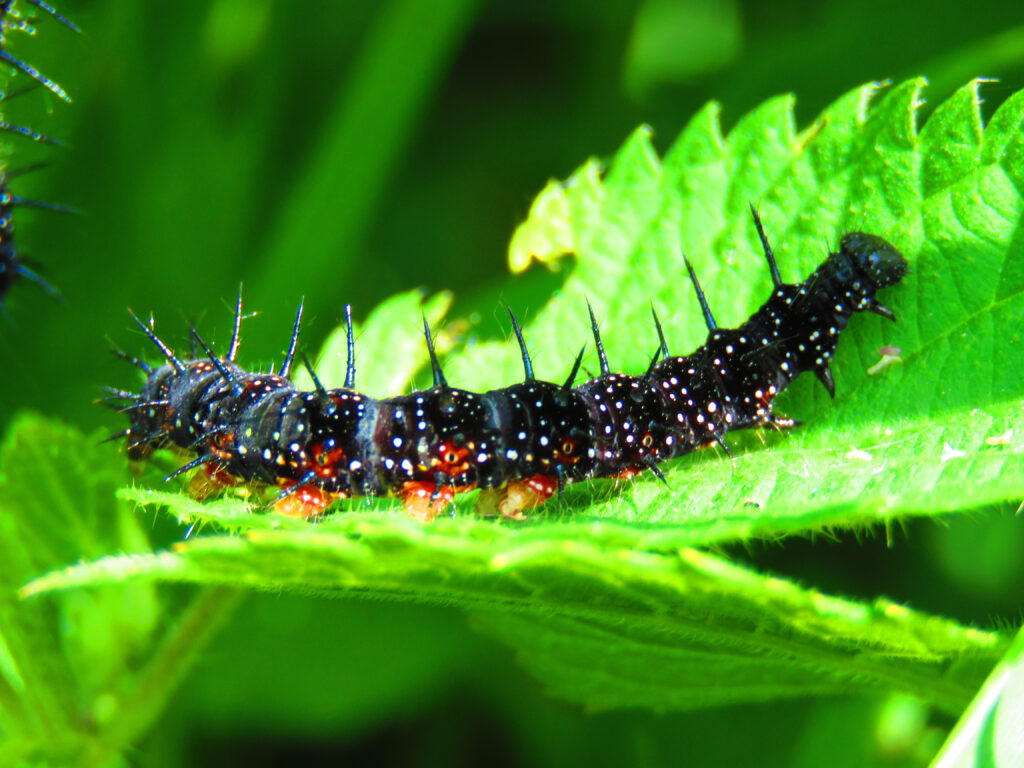
These caterpillars are safe to handle despite their freakish and spiky appearance.
©Przemyslaw Muszynski/Shutterstock.com
Red admirals display different colors throughout their various life stages. They begin as green eggs on a host plant and hatch into black caterpillars adorned with spiky hairs. During the chrysalis stage, they take on the appearance of a brown leaf, blending in with their surroundings, until they eventually emerge as beautiful black, white, and orange adult butterflies.
Despite their intimidating appearance, it is important to note that red admiral caterpillars are perfectly safe to handle and do not pose any risk of causing harm or toxicity. These caterpillars feed on stinging nettles as part of their diet.
Red admiral butterfly caterpillars have a distinctive behavior of folding leaves and securing them with silk, which acts as a way to reveal their location.
11. Spiny Elm Caterpillar (Nymphalis antiopa)
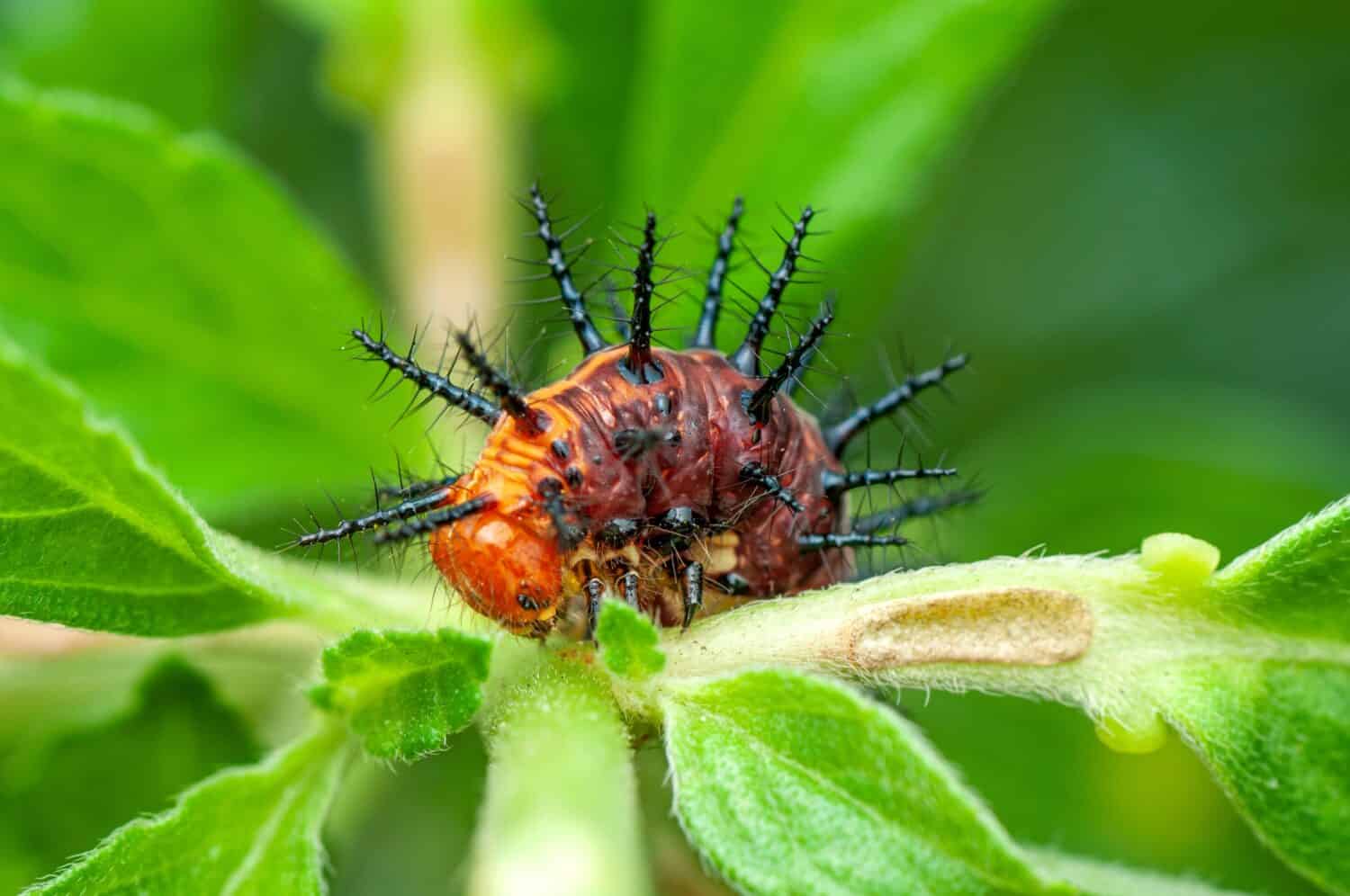
The caterpillar of the mourning cloak butterfly is another common caterpillar found in Montana.
©CHONG LIANG YAN/Shutterstock.com
The spiny elm caterpillar has a visually striking appearance. It can reach up to 2 inches in length and boasts a black body adorned with numerous tiny white dots. Along the middle of its back, between the branched spines that give it its name, there is a row of noticeable red dots.
This caterpillar is the larval stage of the mourning cloak butterfly. It primarily feeds on the foliage of elm trees but can also consume leaves from willow, birch, cottonwood, and hackberry trees.
It is important to exercise caution when encountering the spiny elm caterpillar, as it is poisonous and possesses stinging capabilities. The caterpillar has urticating spines on its body, and contact with these hairs or spines can cause irritation and discomfort when they come into contact with the skin.
12. Thistle Caterpillar (Vanessa cardui)

This caterpillar has lots of spikes on its body and feeds on thistle foliage.
©PixSaJu/Shutterstock.com
Thistle caterpillars are another type of caterpillar found in Montana that exhibit a range of body colors, varying from creamy white to gray-brown. Some may even have a yellow stripe running along the top of their bodies. When fully mature, these caterpillars can measure between 1/5 of an inch to 1.75 inches in length. Interestingly, the thistle caterpillar, despite its spikes, transforms into a remarkable butterfly as it reaches adulthood.
These caterpillars primarily feed on Canada thistle foliage, consuming the leaves while leaving the stem and midrib behind. They are also known to feed on over 100 other plant hosts, including soybeans, sunflowers, corn, mustard, canola, alfalfa, and borage.
It is worth noting that some of these host plants contain toxic compounds, and these caterpillars are able to store these toxins in their hemolymph (blood), rendering them unpalatable to potential predators. You can rest assured that these caterpillars pose no harm to humans.
13. Tiger Moth (Arctia caja)
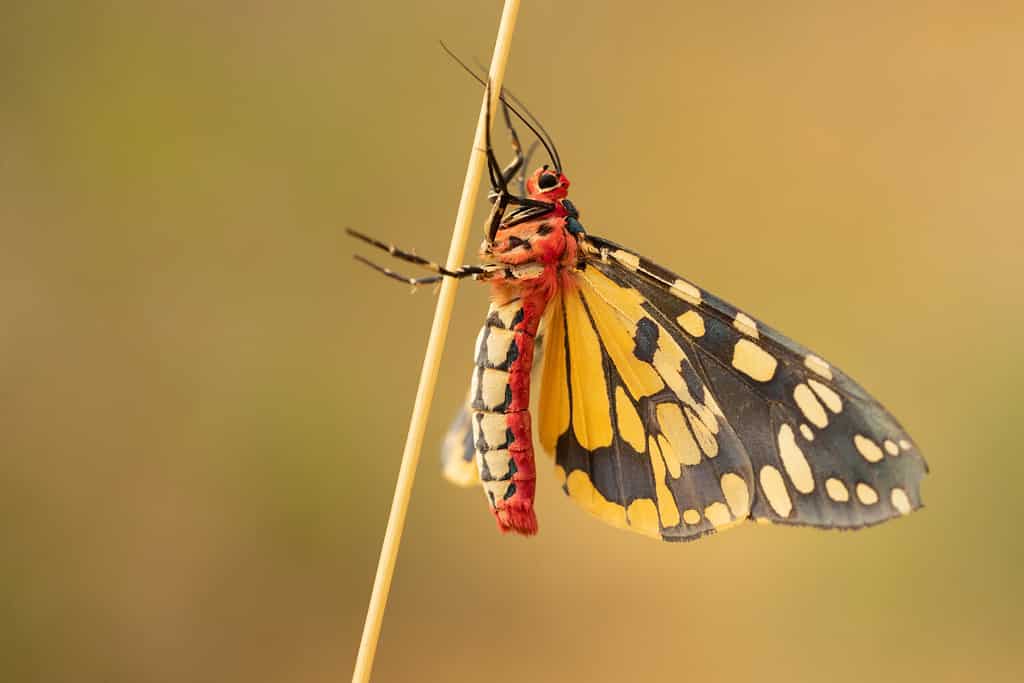
Tiger
moths are gorgeous, colorful moths when fully grown.
©Milan Zygmunt/Shutterstock.com
Mature caterpillars of tiger moths reach a length of approximately an inch and a half. They exhibit a reddish-brown to black coloration and possess tufts of black and yellow hairs on their backs. These hairs have the potential to cause skin irritation and may lead to a rash in some individuals upon contact.
The diet of these caterpillars consists of a wide range of low-growing herbaceous plants, including dandelion, dock, and plantain.
The distinct patterns displayed on the wings of the adult moth serve as a warning to potential predators. This is because the body fluids of the moth contain poisonous substances. The exact effects of these toxins are not yet fully understood.
14. White Admiral Caterpillar (Limenitis camilla)
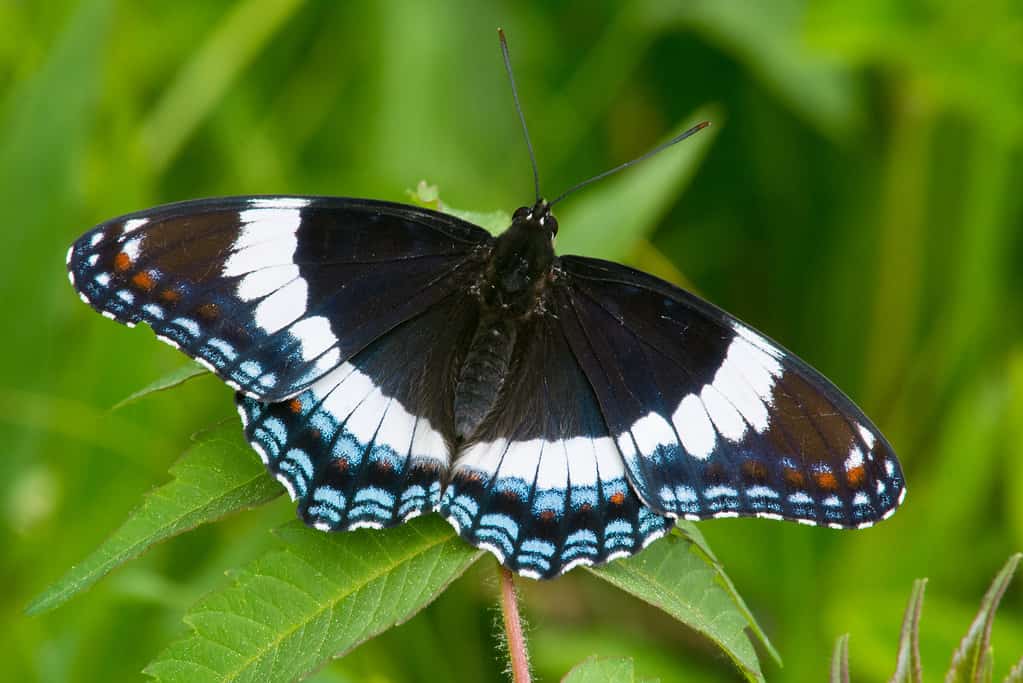
This is the beautiful butterfly that the white admiral caterpillar transforms into.
©iStock.com/bookguy
The caterpillar of the white admiral butterfly is another species that cleverly resembles bird droppings, effectively deterring potential predators.
Regardless of its geographic location, the caterpillar consistently adopts this appearance. It features two branching antlers behind its head and a mottled brown-black, gray, or green body. The center of its body displays a distinctive white patch, while segments near the head and rear end are raised, giving the caterpillar a bumpy profile.
Various deciduous trees serve as host plants for the white admiral caterpillar, including willow, oak, basswood, black cherry, and birch. While the caterpillar itself may not be visually appealing, particularly to birds, the adult butterfly is widely admired for its beauty.
This caterpillar is not known to be poisonous or harmful in any way.
15. Fall Webworm (Hyphantria cunea)
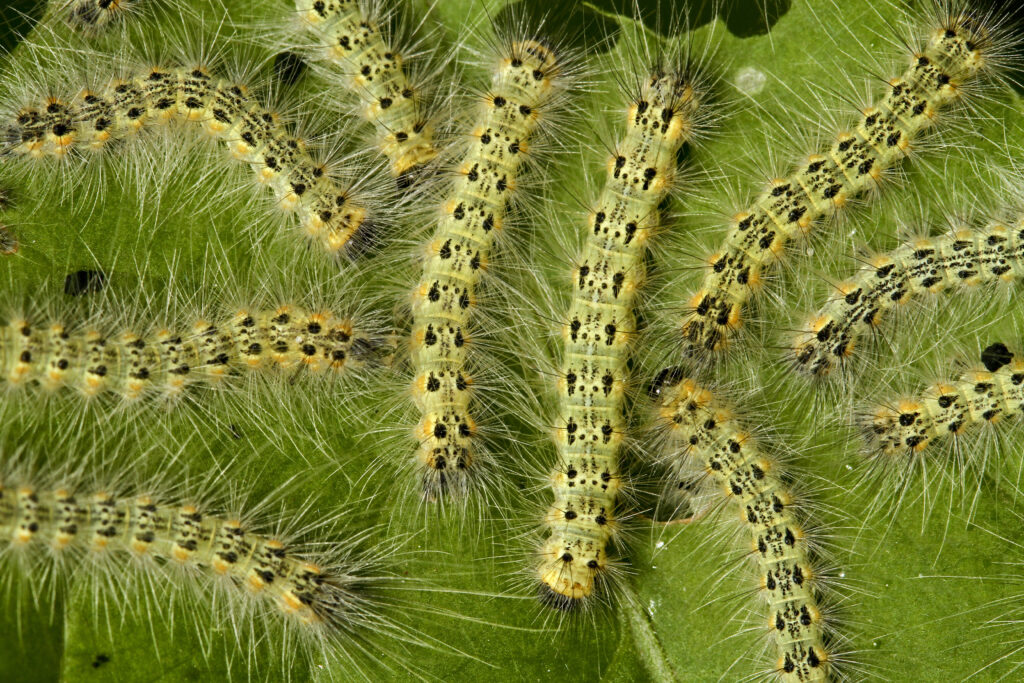
This, the fall webworm, is another caterpillar found in Montana.
©Geza Farkas/Shutterstock.com
Fall webworm caterpillars exhibit a wide range of coloration, varying from pale yellow to dark gray. They are characterized by yellow spots, both long and short bristles, and two cream stripes along the sides. Notably, there are two distinct races of this caterpillar, with differences in head capsule coloration between the more common northern race and the southern race.
The webs created by fall webworm caterpillars are progressively enlarged and appear more messy compared to those of tent caterpillars. These caterpillars have a diverse diet and feed on nearly 90 species of deciduous trees. They commonly target hickory, birch, walnut, cherry, and crabapple trees.
It is important to note that fall webworms are not harmful or poisonous. They do not bite and are generally considered to be more of a nuisance pest. While the webs they create may be unsightly, the defoliation caused by fall webworms typically has little impact on the overall health of the tree.
Regions in Montana with the Most Caterpillars
Montana, known for its expansive landscapes, also hosts a variety of caterpillars. The western region, blessed with a lush, vegetative environment, witnesses the highest concentration of these creatures. Next is the Great Plains area, where caterpillars thrive due to the area’s abundant plant life.
Finally, the Eastern Prairies too accommodate a fair population owing to its moderate grasslands. The abundance of flora in these regions provides ample food and habitat, making them ideal for caterpillar proliferation.
Summary of Caterpillars Found in Montana
| Caterpillar | Butterfly or Moth? | Poisonous? | |
|---|---|---|---|
| 1. | American Lady Caterpillar | Butterfly | No |
| 2. | American Lappot Moth | Moth | Yes |
| 3. | Army Cutworm | Moth | No |
| 4. | Banded Woolly Bear | Moth | No |
| 5. | Monarch Caterpillar | Butterfly | Yes |
| 6. | Viceroy Caterpillar | Butterfly | Yes |
| 7. | Cecropia Moth Caterpillar | Moth | No |
| 8. | Forest Tent Caterpillar | Moth | No |
| 9. | Orangedog Caterpillar | Butterfly | No |
| 10. | Red Admiral Caterpillar | Butterfly | No |
| 11. | Spiny Elm Caterpillar | Butterfly | Yes |
| 12. | Thistle Caterpillar | Butterfly | Yes |
| 13. | Tiger Moth | Moth | Yes |
| 14. | White Admiral Caterpillar | Butterfly | No |
| 15. | Fall Webworm | Moth | No |
The photo featured at the top of this post is © CHONG LIANG YAN/Shutterstock.com
Thank you for reading! Have some feedback for us? Contact the AZ Animals editorial team.




